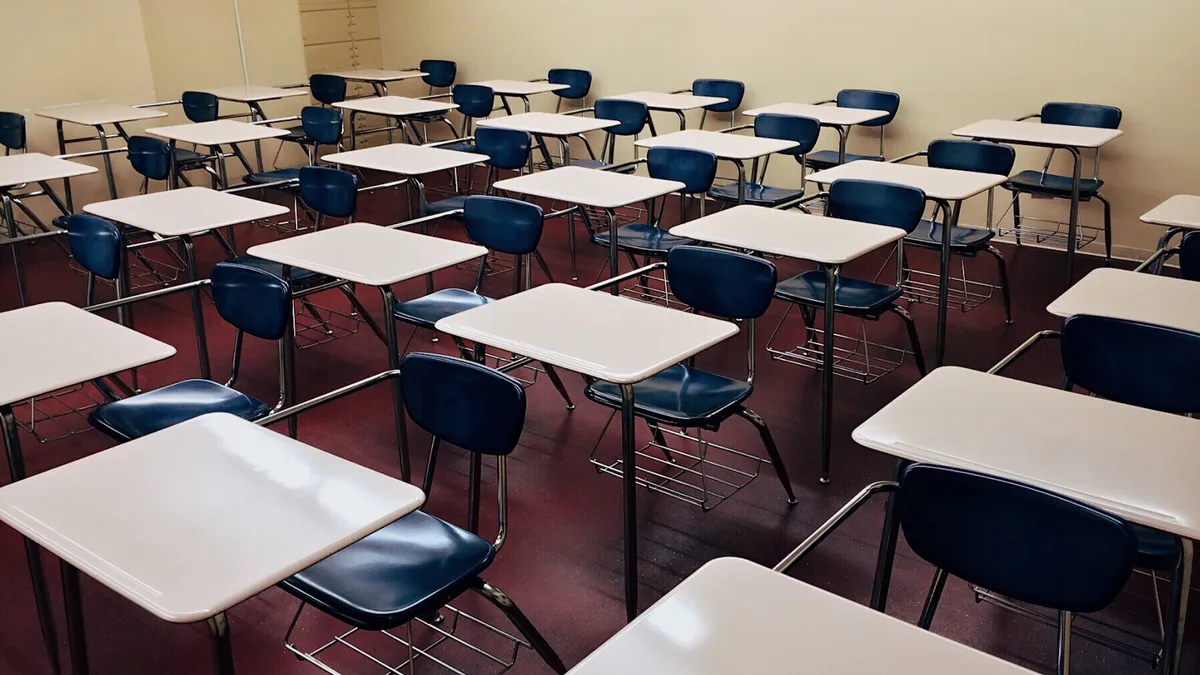Dive Brief:
- As statewide school attendance data from 2020-21 trickles in, an analysis of 17 California school districts reveals chronic absenteeism is worsening this academic year. The research conducted by School Innovations & Achievement, a company that provides programs to districts to reduce school absenteeism, found a chronic absenteeism rate of 27.4% in October 2021, compared to 18% in October 2020 and 11.2% in October 2019.
- Black and Hispanic/Latino students experienced the highest chronic absenteeism rate, according to School Innovations & Achievement. Black students had a 34.6% rate of chronic absence, while Hispanic/Latino students had a 29.9% rate, White students had a 22.4% rate, and Asian students had an 11.4% rate.
- Moving forward, the analysis recommends prioritizing outreach to students who were chronically absent last year and involving all school departments to focus on attendance by sharing data across teams. The analysis further advises implementing a separate pandemic-related absence code for "excused," and that districts should double down on public communication regarding the importance of attendance.
Dive Insight:
Several states released data in recent months showing increases in chronic absenteeism for the 2020-21 school year, and the analysis of 17 California school districts illustrates the pandemic is still taking a toll this academic year, and that chronic absenteeism is only likely to continue rising.
“This year, we believe chronic absence rates are even more elevated given the rough start to school with buildings opening for in-person instruction just as the Delta variant was spreading,” said Hedy Chang, executive director of nonprofit Attendance Works, in an email. “Early chronic absence is especially problematic, as the beginning of the school year is so critical for gaining foundational knowledge that supports success in class later in the school year and building relationships to peers and teachers.”
Typically, states collect attendance data in the summer once a school year is over, and then the collective data is published in the late fall or early winter, Chang said. So far, several states have released chronic absenteeism data for the 2020-21 school year, all revealing the problem has increased since the pandemic struck in 2020.
About 21% of students in Illinois were chronically absent during the 2020-21 school year, an increase from 17% in 2018-19, according to the Illinois State Board of Education. In Massachusetts, 17.7% of students were chronically absent in 2020-21, compared to 12.9% in 2018-19.
Ohio and Connecticut showed even larger percentage-point increases. Some 24% of Ohio’s students were chronically absent in 2020-21, compared to 16.7% in 2018-19. In Connecticut, the state reported a 19% chronic absenteeism rate in 2020-21, up from 10.4% in 2018-19.

California has not released its statewide chronic absenteeism data yet. But among the 17 districts analyzed by School Innovations & Achievement, high school districts reportedly have the highest chronic absence rate at 33.9% in October 2021, compared to 16% in October 2019.
While high schools had a higher rate, elementary schools faced a higher rate of increase since October 2020. The analysis found that elementary schools had a chronic absenteeism rate of 25.9% in October 2021, compared to 9.2% in October 2019.
At Long Beach Unified School District, which has nearly 70,000 students in pre-K through 12th grade, the chronic absenteeism rate has doubled between last year and this fall.
The district had a chronic absenteeism rate of 14% in 2020-21, while the rate has doubled to nearly 30% of students this fall, said Erin Simon, the district’s assistant superintendent of school support services.
Simon attributed this uptick to student quarantines, as well as to mental health issues and family crises tied to food and housing insecurities. These crises have shifted families priorities away from school, she said.
“Our families are prioritizing their basic needs before school and many other issues,” Simon said. “COVID has really exacerbated those basic needs and also families’ desires to really take care of those needs before they take care of anything else.”
California schools must report their average daily attendance for the 2021-22 school year to calculate state funding. Simon hopes the state will change guidance for funding and do not find schools financially at fault for the attendance data this year, which is becoming increasingly out of districts’ control.
Catherine Reimer, superintendent and principal of San Ardo Union Elementary District in California, said her one-school K-8 district currently has a 33% chronic absenteeism rate, and enrollment has declined from 120 students last year to 93 students this year.
Reimer agrees this growing absenteeism issue could lead to significant funding problems.
“For us, [that] means a loss in funding unless a legislator steps in to do something about it,” Reimer said.
In Reimer’s district, she said, students became so adjusted to distance learning they just don’t come to school — even though there are no longer any remote classes — because they just don’t feel like it.
“It’s almost like if they don’t feel like going to school that day, they don’t come,” Reimer said. “My secretary on a daily basis has a list of kids that are just not coming to school, and they’re unexcused absences.”
The only way Reimer has been able to address the problem has been through truancy cases with the District Attorney, which she estimated impacts about 20% of students in the small, rural California district.
The problem affects not only a potential loss of funding, but an actual loss in learning, she said.
“We have an entire year's worth of curriculum and standards that need to be covered and when the child is absent … that equates to a huge learning loss,” Reimer said.
The 17 California school districts included in the analysis are Contra Costa, Fresno, Humboldt, Kern, Kings, Los Angeles, Merced, Monterey, Riverside, Sacramento, San Bernardino, San Mateo, Santa Barbara, Santa Clara, Sutter, Tulare and Ventura.








 Dive Awards
Dive Awards






